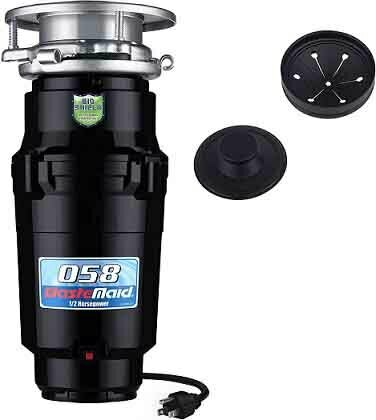Garbage disposals are convenient things in your kitchen that can save you a bunch of time by eliminating food wastes. It works on a very simple principle, yet there are quite a few questions that customers seem to be asking. The most common one is, do garbage disposals have blades?
For reasons concerning safety and durability, most well-known garbage disposals do not have blades.
Irrespective of whether or not they have blades, there are more things that you should know about garbage disposals to use them properly and safely. It is also essential to understand how it works.
In this article, we will be talking about everything you need to know to use garbage disposal safely.
Table of Contents
Do Garbage Disposals Have Blades: How a Garbage Disposal Works?

The main task of garbage disposal is to take out food waste without requiring any effort from the owner.
It follows a very straightforward set of actions and mechanics to remove the waste efficiently. Also,its fast working function makes your kitchen work a lot easier.
Garbage disposal essentially works to constantly break down the trash and waste thrown at it to the point where the waste is turned into particles.
Then it mixes the particles with tap water and flushes it to your waste pipe, almost like a toilet.
Here is an easy to understand in-depth explanation as to how garbage disposals work –
Breaking Down the Waste
It is the first thing the machine does to get rid of the garbage. When you throw the waste at your disposal, it starts shredding it.
The machine contains a very powerful motor that spins a disk with a couple of impellers. It is called the flywheel. This disk catches the waste and starts spinning them.
On the sides, there is are small, tooth-like edges, called grind ring. The disk spins the waste and uses centrifugal force to constantly smash and crush the garbage against the flywheel and the grinding until they turn into particles.
As you can see now, there are no blades involved in the process; it happens purely with the help of pressure, force, and speed.
Flushing out the Waste
While the waste is being powdered, the disposal sprays water with great force. It helps to crush the waste and mixes the debris with water.
This is done to easily remove the waste by flushing it out through your house’s waste pipe.
After the waste has liquefied, it flushes the wastewater with a high force and becomes ready for another session of garbage disposal.
How to Use a Garbage Disposal

Operating garbage disposal is straightforward and convenient. Only a couple of simple steps are required to get it working. Here’s what you need to do-
- Release the cold water tap and let it run for a while.
- Turn on the garbage disposal using the switch.
- Place and push the food wastes into the disposal slowly. (Avoid putting too many big pieces or large amounts at once.)
- After the waste has been broken down; you can turn off the disposal. Rerelease the cold water tap, and let it run to flush out the trash.
And that’s it; it’s that easy. It usually takes only a couple of seconds to complete the entire process.
What to and Not to Put in a Garbage Disposal
The garbage disposal is a pretty small and compact machine, and it does not work like a blender as most people think it does.
So, there are some limitations as to what you can put into it. It is generally made for small food wastes. However, putting in wrong things can seriously damage it.
Things You Can Put in
- Fruit remains or half-eaten fruits, such as apples, orange peels, etc.
- Veggies and vegetable peels.
- Chicken bones small bones such as fish.
- Fatless meat.
- Leftovers from fast foods.
Things You Should Not Put in
- Any kind of oil or grease, such as curry.
- Hard bones.
- Anything other than food.
Oily things can’t be broken down, and they do not wash away with water.So putting in oily stuff will make the disposal dirty and reduce its lifespan.
That is also why you should use cold water because cold water keeps the oil solid to wash away with ease.
Do garbage disposal blades wear out?
Yes, the components inside a garbage disposal, including the blades (also called impellers or grinding elements), can wear out over time. However, several factors determine the lifespan of these blades:
Material Quality: Higher-end garbage disposals tend to use more durable materials, like stainless steel, for their blades, which resist corrosion and wear better than less expensive materials.
Usage: If you frequently use your garbage disposal or if you put very hard items (like bones) or non-food items down it, the blades can wear out more quickly.
Maintenance: Regular maintenance, like running cold water while using the disposal, not putting greasy or stringy items down it, and occasionally grinding up ice or citrus peels, can help keep the blades sharper and extend their life.
Design: Some garbage disposals don’t actually have “blades” in the traditional sense. Instead, they have impellers that swivel or lugs that push food against a stationary grind ring, pulverizing the waste. These systems can also wear down, though they might not “dull” like a traditional blade.
Foreign Objects: Non-food items, such as utensils, can sometimes find their way into the disposal. These can damage or dull the blades upon contact.
If you find your garbage disposal isn’t grinding food as effectively, it’s making unusual noises, or it’s clogging frequently, it might be an indication that the internal components, including the blades, are wearing out. Depending on the unit’s age and quality, it might be more cost-effective to replace the entire garbage disposal rather than attempting a repair.
Are garbage disposal blades sharp?
Garbage disposals don’t actually have “blades” in the way that you might imagine a knife or a pair of scissors. Instead, they have impellers (sometimes referred to as lugs or swivels) that are mounted on a spinning plate. When you turn on the disposal, these impellers, in conjunction with the spinning action, force the food waste against a grind ring or shredder ring. This grind ring breaks down the waste into very fine particles, which are then flushed down the drain with water.
The impellers and the grind ring are typically made of metal, and while they are tough and durable, they aren’t “sharp” in the traditional sense. Instead, they work more by force and grinding action rather than slicing.
However, it’s essential to treat garbage disposals with respect. Always avoid sticking your hand or fingers inside, even if the disposal is off. If you need to retrieve something from a disposal or clear a jam, always turn off the power at the breaker or unplug the unit first. Use tongs or pliers to retrieve items rather than your fingers.
What is inside a garbage disposal?
A garbage disposal, also known as a waste disposal unit or garburator, is a device usually electrically powered, installed under a kitchen sink between the sink’s drain and the trap. It shreds food waste into pieces small enough to pass through plumbing. Here’s a general breakdown of its components and their functions:
Housing: A cylindrical chamber made of durable metal or hard plastic that contains all the inner components of the disposal.
Grinding Chamber: Inside the housing, where food waste is ground up. It’s typically made of glass-filled nylon or stainless steel for durability.
Grinding Components (or Impellers): These are the blades or lugs that swirl and spin to grind the food particles. Contrary to popular belief, most garbage disposals do not have sharp blades. Instead, they have two impellers (swiveling lugs) that are mounted on a spinning plate. They use centrifugal force to push food waste against the grinding ring, where it’s then broken down.
Grinding Ring: This is a stationary component inside the grinding chamber, and it works with the impellers to grind the food down. It’s like a wall with a rough surface against which the impellers force the food waste to be ground.
Motor: An electric motor that provides the power to spin the plate with the impellers. Motors in most residential garbage disposals typically range from 1/3 to 1 horsepower.
Flywheel (or Turntable): This is the spinning plate onto which the impellers are mounted. It’s driven by the motor and rotates to grind the waste against the grinding ring.
Hopper (or Feed Chamber): The funnel-shaped entrance where food waste is fed into the disposal.
Reset Button: In case the motor gets overloaded and shuts off, the reset button is used to reset the motor after clearing the jam.
Drain: After grinding, the food particles mixed with water flow out of the disposal through this drain and into the plumbing.
Splash Guard: This is a rubber component at the top of the disposal where food waste is fed in. It prevents water and food particles from splashing out while the disposal is running.
Auto-reverse Function: Some modern garbage disposals come with this feature that helps in clearing jams by making the turntable rotate in the opposite direction for a moment.
Seal and Insulation: These components reduce the noise produced by the garbage disposal and prevent leaks.
Power Switch: Located externally, often on the wall or under the sink. It controls the operation of the disposal.
When you turn on the garbage disposal, the motor powers the flywheel and impellers, causing them to spin rapidly. As food waste is pushed into the disposal, it’s caught by the spinning impellers, which force it against the grinding ring, breaking it down into tiny particles. Water from the sink’s faucet then flushes these particles through the grinding chamber and into the drain system.
It’s important to note that not all waste should be put into a garbage disposal. Items like grease, oil, bones, fibrous vegetables (like celery), and non-food materials can clog or damage the unit. Always consult the user manual for your specific disposal model to know what can and cannot be processed.
Maintenance and Lifespan
Garbage disposal is widespread in houses these days. They last a really long time if taken care of well and used frequently.
There are no maintenance check-ups required unless something does not work correctly. These things are made to last.
But as with all machines, a garbage disposal can have problems too. If you didn’t do anything wrong, you should contact and claim the company’s warranty for most problems. But in case you did, some of the most common issues you might face are-
- Garbage Disposal Blades Not Turning, and
- Garbage Disposal Blades Loose
What to Do If These Problems Occur
When it comes to the blade, it is basically the disk with the impellors that spin. It is an essential component as it is the thing that spins and crushes the foods.
If you ever put something at your disposal that you shouldn’t, it could stop turning or become loose.
There could be a number of reasons for this, the pieces of the waste that you put in might be stuck within the motor, or it might have damaged the screws, so now it’s loose.
If you hear a wobbling noise while it is running, your disposal’s disk might be loose.
To fix both of these, these are the steps you can follow–
- Disassemble the garbage disposal.
- Remove the disk from the motor.
- Look for any dirt or waste stuck in-between; if you find any, clean them carefully.
- Try tightening the screws that connect the disk to the motor.
In case the disk is really damaged, you might have to replace it.
Waste Maid 10-US-WM-058-3B Garbage Disposal

Garbage Disposal Blades Replacement
This is a relatively straightforward process. Once you’ve disassembled the disposal, take out the screws attaching the disk to the motor. Buy replacement disk for the same garbage disposal model. Screw it back in, and you are good to go.
If you haven’t done anything like this before, it is recommended that you seek professional help and support.
OXO Good Grips Silicone Sink Strainer

Also, read Which Garbage Disposal Should I Buy?
Conclusion
To end the conversation for today, do garbage disposals have blades? No, they don’t. In fact, most modern-day garbage disposals don’t even need blades as their motor and design are smart enough for food waste.
Hopefully, we’ve been able to answer this common question regarding garbage disposals and informed you of its proper use.
Related Post:
Best InSinkErator Garbage Disposal

Williams Kane is a blogger and writer. He’s passionate about writing and connecting with the community, especially when it comes to sharing his ideas through writing.
I am a versatile author with a passion for exploring a wide range of topics on our multi-niche website. With a background in research and a love for writing, I bring a unique blend of expertise to our platform.
My journey began in the world of science, where I earned a degree in biology and developed a deep fascination for the natural world. This background enables me to delve into topics related to ecology, environmental conservation, and the wonders of the animal kingdom.
However, my curiosity knows no bounds, and I have ventured into various other niches as well. From technology trends and digital innovations to health and wellness tips, I strive to provide well-researched and engaging content that informs and entertains our diverse audience.
Furthermore, my dedication to staying current with the latest developments in each niche ensures that our readers receive up-to-date and reliable information. Whether it’s deciphering complex scientific concepts or simplifying tech jargon, I take pride in making complex subjects accessible to all.
Join me on our multi-niche journey, where we explore the depths of knowledge and share insights on a multitude of topics to inspire, educate, and entertain.










Comments are closed.